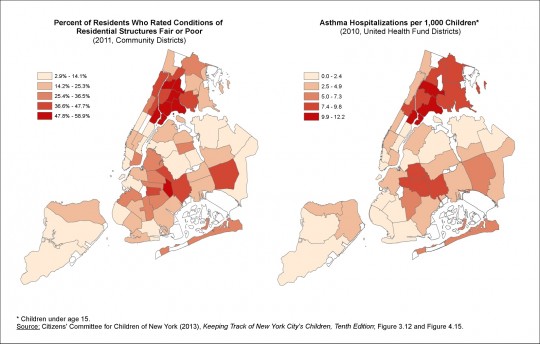Blog
|
February 28, 2013 Concentrations of Risk: Asthma and Poor Housing Conditions
Click here for full sized version In New York City, over 39,000 children under the age of 15 visited the emergency room because of asthma in 2010. About 7,400 children – five out of every 1,000 – had cases that were serious enough that they needed to be hospitalized. It is estimated that about 70 percent of asthma sufferers also have allergies.[1] While the causes of asthma are still unknown, mold and other allergens are known triggers for asthma attacks. This recent New York Times slideshow shows the poor conditions in which many people in public housing and low-income neighborhoods in New York City live. It also highlights the link between housing conditions and health and other outcomes. Many of the images portray residents in bathrooms and kitchens with walls infested with mold; the captions note that residents suffer from asthma. While we don’t have data that identify what triggered the asthma-related hospital visits mentioned above, CCC’s new edition of Keeping Track does include data about where these children live and about the conditions of their neighborhoods. For instance, we know that nearly one-third (32.3 percent) of children who made asthma-related emergency room visits were from the Bronx. Further, certain neighborhoods in the south Bronx and upper Manhattan have much higher rates of asthma hospitalization than the rest of the city. In Hunts Point and Mott Haven in the Bronx, the asthma hospitalization rate is 12.2 per 1,000 children; in East Harlem it’s 11.4. Both are more than double the citywide rate of 5 per 1,000 children. When we look at these patterns geographically and compare them to geographic patterns in housing conditions, we see a striking similarity. (See maps above.) In Hunts Point and Mott Haven in the Bronx and in East Harlem in Manhattan, neighborhoods with higher than average asthma hospitalization rates, about half of residents reported that the residential structures in their neighborhoods were in fair or poor condition (50.4 percent and 49.4 percent respectively). Data from the Housing Vacancy Survey also show that residents in these neighborhoods report the presence of rodents and cockroaches, broken plaster and peeling paint, and water leaks within their apartments at much higher rates than the city as a whole. These are all factors that may be triggers or produce triggers for asthma attacks in asthma sufferers. Unfortunately the data in Keeping Track also illustrate that the barriers to well-being faced by children in these neighborhoods, and others, don’t end there. These neighborhoods are also impacted by higher rates of child poverty, adult unemployment, rent burden, and other risk factors. Also lower percentages of elementary and middle school children in these communities are meeting state standards in reading and math[2] – perhaps not surprising since, according to the National Institute of Allergy and Infectious Disease, nationwide, 59 percent of children with asthma missed school because of asthma in 2008.[3] In New York City, child asthma-related hospitalizations have in fact declined over the last decade, from over 10,000 – or 6.5 per 1,000 children – in 2001 to 7,403 – or 5.0 per 1,000 – in 2010. But these modest gains are now threatened by city and state budget proposals to cut funding for community-based services that help manage and reduce childhood asthma, including reductions to the city’s Asthma Control program and the East Harlem Asthma Center, as well as the state’s Regional Childhood Asthma Coalitions. Given the troubling number of children suffering with asthma and high asthma hospitalization rates in many communities, we must do all that we can to protect investments in the asthma prevention and control services children need.
[1] American Academy of Allergy Asthma & Immunology, Asthma Statistics; retrieved from http://www.aaaai.org/about-the-aaaai/newsroom/asthma-statistics.aspx; (27 February 2013). [2] For community district-level data and statistics, visit our online database at https://www.cccnewyork.org/data-reports/keeping-track-database/. [3] National Institute of Allergy and Infectious Disease, CDC Vitals May 2011: Asthma in the U.S.; retrieved from http://www.niaid.nih.gov/topics/asthma/understanding/Pages/usAsthma.aspx#Risk; (27 February 2013). |
Comments |





comments
Please keep all comments civil and on-topic. CCC reserves the right to remove any comments deemed inappropriate.Interesting ideas , I Appreciate the specifics . Does anyone know if my business can get access to a template CBP 434 copy to use ?
Hi Hortense, my work colleague saw a fillable a form copy at this site
http://goo.gl/vBm5Er.asthma hasIn New York City, child asthma-related hospitalizations have in fact declined over the last decade, from over 10,000 – or 6.5 per 1,000 children – in 2001 to 7,403 – or 5.0 per 1,000 – in 2010. But these modest gains are now threatened by city and state budget proposals to cut funding for community-based services that help manage and reduce childhood asthma, including reductions to the city’s Asthma Control program and the East Harlem Asthma Center, as well as the state’s Regional Childhood Asthma Coalitions.